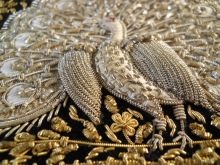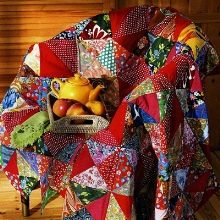Interesting needlework ideas from around the world

There are many different types of needlework in the world. Some of them are already outdated and have lost their relevance, while others, on the contrary, are at the peak of their popularity and are not going to lose their positions. In this article, we will tell you about the most interesting ideas for needlework collected from around the world.



Japanese handicrafts
One of the most popular types of needlework at the present time is amigurumi. This is a small toy in the shape of an animal or other creature that is crocheted or knitted. Such a toy is knitted in a special way, namely: in a spiral, while knitting tightly so that there are no unnecessary holes left.
At the same time, a special hook is chosen to create such a toy. As a rule, it is less than the size that is required for the yarn - this is necessary so that there are no holes in the toy from which the synthetic winterizer can protrude.



Kanzashi is another Japanese type of needlework, the essence of which is to create flowers from fabric. This occupation has recently become especially popular. This is explained quite simply: as a result of the work, a beautiful flower is obtained, which is created from ordinary satin ribbons.
However, it is worth clarifying that in Japan real kanzashi are created from silk, and the fabric itself is held together with rice glue. In our reality, satin ribbons are used, which are fastened with a thread and a needle.


Temari is another creative activity. This is an art form that appeared in Japan in ancient times. It was brought there from China, which happened about 600 years ago. This type of handicraft involves embroidering balls - usually such balls were made for children, often using the remains of old kimonos.Now such a ball is symbolic, it means friendship and loyalty, and according to beliefs, it brings success and happiness to its owner.
Interestingly, in Japanese realities, a real temari master is considered to be the person who managed to pass 4 levels of mastery, that is, weaved about 150 balls and studied for about 6 years.


Another Japanese type of needlework is kusudama, that is, the art of making balls. The name of this hobby literally translates as "medicine ball". This name is explained by the ancient origin of this art form: earlier kusudams were actively used for treatment, because incense and a mixture of dry plants were used in their creation.
But in general kusudama is a ball made of square sheets of paper, which is composed of a certain number of modules, which symbolize flowers and are connected with threads or glue.


Hobbies that came from America
The technique of patchwork was brought to America by settlers from England, Holland and Germany. It happened at the end of the 18th century. There she fell in love, was improved, turning into a national form of creativity. From America, the patchwork technique has already come to us. This kind of handicraft involves the creation of a full-fledged product, which is folded according to the principle of a mosaic from different scraps and remnants of fabric. In this case, all seams are on the wrong side of the product.
The colors of the patches that are used during work can be combined in a variety of ways, the result is a bright and colorful product. By combining fabrics with different colors, patterns, and sometimes even texture, an individual thing comes out, which is impossible to repeat. This type of needlework is suitable as a home hobby: with your own hands you can make a rug, bedspread or something else from scrap materials.



Needlework in Russia
Earlier, one of the most popular types of needlework in Russia was weaving, the technique of which varied depending on the region. At that time, in particular, bast shoes were woven, because they were most often worn by almost all peasants, which is explained by the high cost of ordinary leather shoes at that time. In addition, it was difficult and pitiful to wear such expensive leather things, because the peasants constantly had to work, and this work was, as a rule, dirty.
And wicker sandals, on the contrary, were not a pity, because they are easy to make, and do not cost so much. Such shoes were woven from the bark or underbrush of deciduous trees, and sometimes from the roots of plants, using a special hook called a kochedyk.


Quite popular in Russia, especially when it comes to the peoples that lived in the northern regions, was felting, for which the wool of sheep and other animals was used.
Felting was used to make warm felt boots and some other things.


Wooden cutlery, in particular, spoons, were also actively made in Russia. They began to make them only after the Russian people were baptized by Vladimir. Before that, there was no cutlery in use, and people, as strange as it may sound now, ate with their hands. Only after baptism was a decree issued stating that food must be brought to the mouth with a spoon.
So the art of creating spoons from wood of different varieties began to develop - most often they used linden, rowan and apple trees. These spoons came in a variety of shapes and colors. After some time, they began to be used as musical instruments.


Another popular Russian craft is pottery. Previously, this lesson was especially relevant, because people needed dishes for household needs. They began to make dishes from clay, which subsequently led to the birth of pottery.
This skill has usually been passed down from generation to generation in the past. The artisans themselves often put their products up for sale, thus generating income.Often the dishes they made were decorated with various patterns and paintings.


Hand made from other countries
Such an art form as carving is very interesting. He came to us from the Ancient East. If we talk about carving, then this word is translated as "carving", and carving on a variety of materials: wood, stone, bone and more.
Now, for example, fruit and vegetable carving is very popular. They create wonderful crafts, which, unfortunately, cannot be stored for a long time. However, such products will become a beautiful and original decoration for a festive table.


Encaustics is no less interesting - a special drawing technique that requires an iron. This technique originated in ancient Greece, and now it has gained particular popularity. It is quite simple to carry out drawings in this technique: this will require wax crayons, thick cardboard and the iron itself.
A layer of wax crayons must be applied to the sole of the iron, after which it is imprinted on cardboard. This can be done several times, then it all depends on your imagination and imagination - you can draw anything in this way.


Handicrafts that came from India, which are called zardozi, are also quite popular. It is an amazing art that is embroidery using gold, silver, pearls, silks and velvet.
Various lush paintings, carpets, dresses and other clothes are often performed in this technique. Such products look interesting, pretentious and rich.



Another popular type of needlework at the present time is quilling. This hobby has European roots. It involves the use of thin paper strips. They are twisted using a special device or an ordinary toothpick.
From the resulting curls, a picture is formed in the future. This technique is often used to create beautiful greeting cards.










